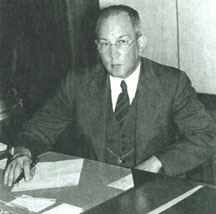

Moultrie High School for Negro Youth “I will always cherish the memory of this school. We were a community.
|
|||||||||||||||||
Moultrie High School for Negro Youth was added to the list of participating sites in 1942 after the closing of Atlanta University Laboratory School and its withdrawal from the project. During the 1940s, Moultrie, located in Southwest Georgia, was primarily an agricultural community. While the setting represented a rural-town school, the teachers were closely aligned with Albany State College, although Moultrie did not serve as an off-campus laboratory school student-teaching site and Albany State maintained an official laboratory school. Moultrie High, with its extensive 1946 final report, Miss Parker: The New Teacher, was one of the more active participants in the project, an interpretation confirmed by Cynthia Gibson Hardy’s research where she referred to the school as one of the more experimental programs.
Comments about the 2018 publication, "After reading Becoming an African American Progressive Educator and the chapter, Miss Parker: The New Teacher, published in 1946 and written by faculty of Moultrie High School for Negro Youth, Odessa Walker Hooker stated that the chapter brought back so many vivid memories of school life and displayed the importance of community. 'The format used in reporting was appealing; the letters between Miss Parker and Miss Mitchell added warmth and reality to the research. Our Moultrie teachers treated us as people and not just as students. As a professional educator, this is a lesson I have never forgotten'."
|
|||||||||||||||||
|
Letter of Invitation to Participate in the Study January 23, 1940 |
||||||||||||||||
| While the Association sought to achieve accreditation for its member schools and to make strides for equitable support—separate AND equal—for black education, some educators believed teachers were not involved in progressive education’s “stream of educational ideas” and, thus, were placing too much emphasis on traditional instructional practices. For this reason, the Rockefeller Foundation invited distinguished schools to help define promising practices and to serve as a laboratory for determining goals for black youth. | |||||||||||||||||
With oral history interviews conducted in December 2009 with |
|||||||||||||||||
left to right: |
|
||||||||||||||||
  |
|||||||||||||||||
Dale Williams |
|||||||||||||||||
With special thanks to LaVerne McLaughlin and Shabreda Ray of Albany State University, La Shay James of the Frank Ryce Community Center, and Dale Williams of the City of Moultrie, and with great appreciation to Otis Baker and George Walker for providing important source materials for this exhibition. Archival materials from University Archives, James Pendergrast Memorial Library of Albany State University were used in this research. |
|||||||||||||||||
|
|||||||||||||||||
| The Museum of Education’s Web Exhibitions center primarily on the academic life of individual schools during the 1940s and early 1950s, the focus of the Secondary School Study. Our vignettes serve not to lessen the accomplishments and accolades from prior or subsequent decades nor do they diminish the significance of the social and athletic dimensions of school life. Instead, the Museum presents web exhibitions of the Secondary School Study schools as a way to feature the experimental efforts of progressive educators during the 1940s. Since these vignettes were not prepared to serve as school histories, we encourage alumni and historians to prepare their own comprehensive school accounts, histories, and memoirs of these important educational institutions. | The Museum of Education’s Web Exhibitions have been prepared for a general audience and have not used professional terminology from the field of education. Our accounts are intentionally free of detailed bibliographic citations. The curator is currently writing a scholarly account of this project that follows accepted bibliographic practices. |
||||||||||||||||
 |
Further, these exhibitions are conceived within a tradition of progressive education where a fruitful experience raises as many questions as it answers. Thus, the information on the various sites has been crafted intentionally to be suggestive—to allow important questions "to float" through the exhibitions rather than to be answered with a false sense of certainty. These sites are works-in-progress and represent an "educational research charrette" as additional historical material is discovered and fresh memories, recollections, and insights come forth by participants and researchers. |
||||||||||||||||

an institutional member of the International Coalition of Sites of Conscience
Museumofed@gmail.com







